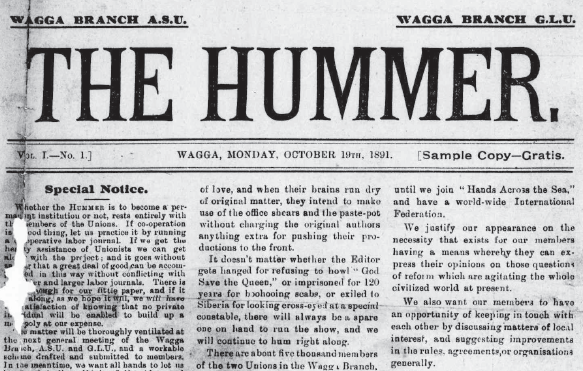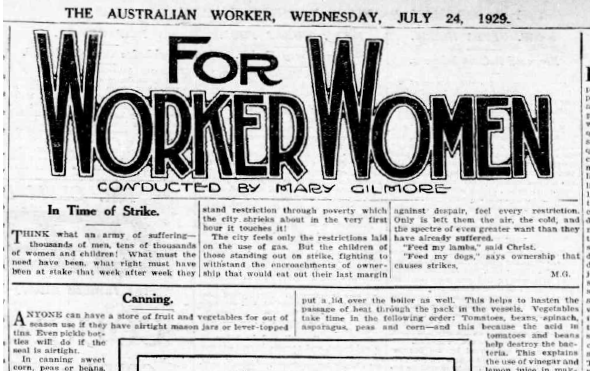The Worker remains firmly embedded in our nation's history, featuring some of Australia's greatest writers and leaders, and at the height of its popularity, drove the national debate of a generation.
The Hummer
The Hummer, a joint effort of the Amalgamated Shearers' Union and the General Workers Union (who merged in 1894 to form the AWU), was first published on the 19th of October, 1891.
The Hummer was intended to provide a printed voice in support of workers' rights, when "many or most mainstream newspaper proprietors and editors were sufficiently hostile to Unionism." The Hummer ran until September 3, 1892, where it was incorporated into the Sydney Worker.

The first edition of The Hummer
The Worker (Brisbane)
The Brisbane edition of The Worker was first published on the 1st of March, 1890, founded by William Lane. The Worker documented the shearers' strikes and birth of the Labor Party in the early 1890's, and contributors included Henry Lawson. "The Freedom on the Wallaby," one of Lawson's most well-known poems, was first published in The Worker in May 1891.
 Lawson's 'Freedom on the Wallaby' was first published in The Worker
Lawson's 'Freedom on the Wallaby' was first published in The Worker
Journalist Henry Boote edited The Worker from 1901 to 1911, when he was called down to edit the Sydney publication. The Brisbane Worker ran until 1974, when it was incorporated into The Australian Worker.
 The first edition of the Brisbane Worker
The first edition of the Brisbane Worker
The Westralian Worker
The West Australian paper was first issued in Kalgoorlie on September 7, 1900. In 1912, production of The Westralian Worker moved to Perth, and offices were housed in the AWU's West Australian headquarters.
 The first edition of the Westralian Worker
The first edition of the Westralian Worker
Its most famous contributor is wartime Prime Minister John Curtin, editor from 1917 until 1928. Curtin sought to re-align The Westralian Worker with the policies of the West Australian Labor Party. The newspaper closed in 1951, due to a shortage of newsprint and "insurmountable difficulties".
The Australian Worker
In September 1892, The Worker was first published in Sydney, incorporating the Hummer paper.

The first edition of The Australian Worker
The Worker was renamed The Australian Worker in 1913. Publication peaked during World War 1 - some 27,000 AWU members served at the front, and the paper contained a regular feature dedicated to the workers "fighting in the old world for the new."
During the Conscription Referendum of 1916, The Australian Worker heavily backed the 'No' vote, issuing over 6 million pamphlets, posters, cards, stickers and supplement issues.

Anti-conscription cartoon published in October 1916.
Led by editor Henry Boote, the paper was one of the most prominent and influential voices during the Anti-conscription campaign, which remains a defining moment in the AWU's early history.
The Australian Worker's most recognised ongoing contributor is without a doubt Dame Mary Gilmore, whose Women's Page ran from 1908 to 1931. Gilmore's page was unique, directed specifically at the women of the working class.

One of Gilmore's many Women's Pages
As workers fought for wage justice and decent working conditions, Mary Gilmore offered practical advice for wives and mothers at home struggling with limited budgets. She also published letters from unionist women and girls, and a selection of her own poetry.
Reading The Worker Today
Early issues of the Worker's four imprints are now fully digitised and available to read on Trove, courtesy of the National Library.
Each paper is available to view in full below:
The Hummer (1891-1892): https://go.awu.net.au/The-Hummer
The Sydney Worker (1892-1913): https://go.awu.net.au/Sydney-Worker
The Brisbane Worker (1890-1955: https://go.awu.net.au/Brisbane-Worker
The Australian Worker (1913-1950): https://go.awu.net.au/Australian-Worker






